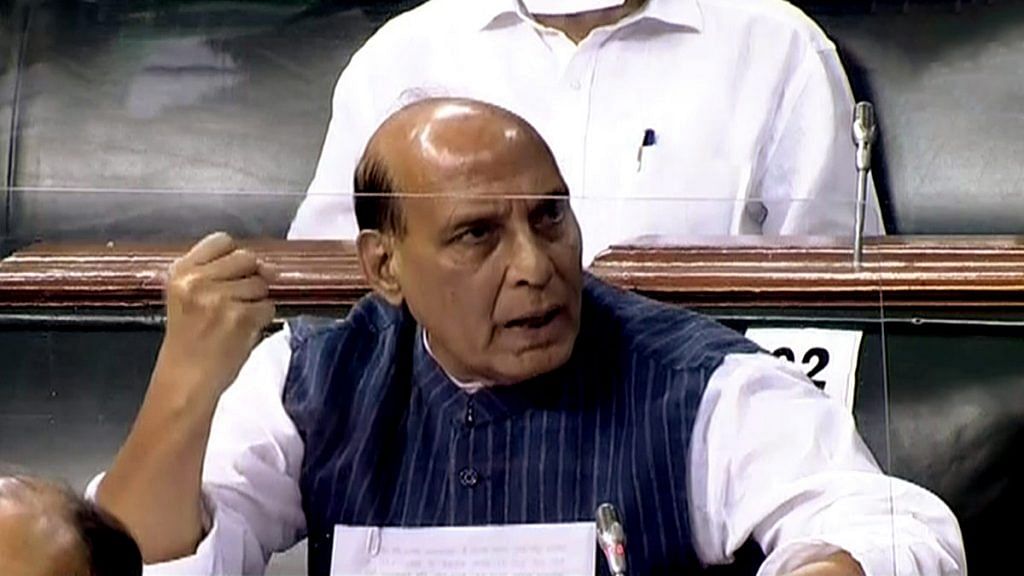New Delhi: The Narendra Modi government Tuesday briefed Parliament on the ongoing tensions with China, admitting that India was facing a “challenge in Ladakh”, but choosing to remain ambiguous about operational details, including how far the Chinese have come into Indian territory.
Defence Minister Rajnath Singh made it absolutely clear that China is the aggressor, and that the Indian forces have done counter-deployment to challenge the neighbour’s attempts to unilaterally change the status quo at the Line of Actual Control.
Rajnath Singh read out a statement in the Lok Sabha, saying the violent conduct of Chinese forces has been in complete violation of all mutually agreed norms.
“I will not hesitate to share with this august House that we are facing a challenge in Ladakh,” he said, adding that in the past too, India has had situations of prolonged stand-offs in border areas with China, which have been resolved peacefully.
“Even though the situation this year is very different, both in terms of scale of troops involved and the number of friction points, we do remain committed to the peaceful resolution of the current situation. At the same time, the House can be assured that we remain prepared to deal with all contingencies,” the defence minister said.
Also read: China miscalculated India resolve, needs exit strategy now, says former Ladakh corps commander
How the stand-off unfolded
Giving details about how the tensions escalated, Rajnath Singh said in April, China started building up troops and equipment at the LAC.
“Since April, we had noticed a build-up of troops and armaments by the Chinese side in the border areas adjacent to eastern Ladakh,” he said.
Then, in early May, the Chinese took action to hinder the “normal, traditional patrolling pattern” of Indian troops in the Galwan Valley area, which resulted in a face-off.
“Even as this situation was being addressed by the ground commanders as per the provisions of our bilateral agreements and protocol, in mid-May, the Chinese side made several attempts to transgress the LAC in other parts of the western sector (i.e. Ladakh). This included Kongka La, Gogra and the north bank of Pangong Lake. These attempts were detected early and consequently responded to appropriately by our armed forces,” the defence minister said.
As reported by ThePrint, Indian forces responded to Chinese transgressions with “mirror deployment”.
Singh added that India had made it clear to China, both through diplomatic and military channels, that by such actions, it was attempting to unilaterally alter the status quo, and that this was unacceptable.
“Given the growing friction along the LAC, the senior commanders of the two sides in a meeting on 6 June agreed on a process of disengagement that involved reciprocal actions. Both sides also agreed to respect and abide by the LAC and not undertake any activity to alter the status quo. However, in violation of this, the Chinese side created a violent face-off on 15 June at Galwan,” he said.
The minister underlined that Indian soldiers laid down their lives and also inflicted costs, including casualties on the Chinese side.
“The conduct of our armed forces throughout these incidents shows that while they maintained clam in the face of provocative actions, they also equally displayed gallantry when required to protect the territorial integrity of India,” he said.
Also read: Fresh India-China corps commanders’ talks will have new terms of engagement, challenges
Mutual respect and sensitivity with neighbours
Rajnath Singh also said that while no one should doubt India’s determination to safeguard its borders, the country believes that mutual respect and mutual sensitivity are the basis for peaceful relations with neighbours.
“As we want to resolve the current situation through dialogue, we have maintained diplomatic and military engagement with the Chinese side,” he said.
The minister added that in these discussions, India has maintained the three key principles that determine its approach — both sides should strictly respect and observe the LAC; neither side should attempt to alter the status quo unilaterally; and all agreements and understandings between the two sides must be abided by in their entirety.
China, on its part, took the position that the situation should be handled in a responsible manner and ensure peace and tranquillity according to bilateral agreements and protocol, he told the Lok Sabha.
“Even as these discussions were going on, the Chinese side again engaged in provocative military manoeuvres on the night of 29 and 30 August in an attempt to change the status quo in the south bank area of Pangong Lake,” Singh said.
“But yet again, timely and firm actions by our armed forces along the LAC prevented such attempts from succeeding.”
He explained that as of now, the Chinese side has mobilised a large number of troops and armaments along the LAC, as well as in the ‘depth areas’, and that there are several friction areas in eastern Ladakh, including Gogra, Kongka La and the north and south banks of the Pangong Tso.
“In response to China’s actions, our armed forces have also made appropriate counter deployments in these areas to ensure that India’s security interests are fully protected,” Singh said, adding that the House should have full confidence that “our armed forces will always rise to the challenge and do us all proud”.
“This is still an ongoing situation and obviously involves sensitive operational issues. I would, therefore, not be able to give more details in public, and I am confident about the understanding of the House in this regard,” he said.
Also read: Why LAC could end up like LoC with more Indian Army deployment after China tensions ease
